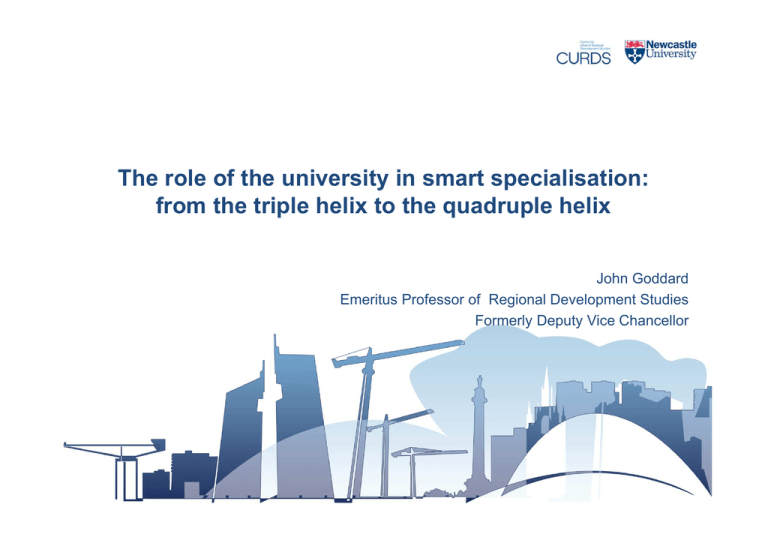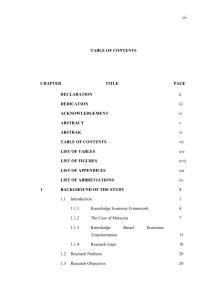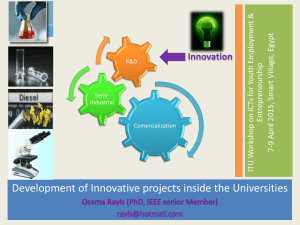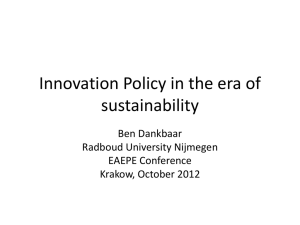Workshop1_John Goddard
advertisement

The role of the university in smart specialisation: from the triple helix to the quadruple helix John Goddard Emeritus Professor of Regional Development Studies Formerly Deputy Vice Chancellor The disconnected region PUBLIC SECTOR Lack of coherence between national and regional/local policies PRIVATE SECTOR Lack of political leadership No coordination or representative voice with which to engage Lack of a shared voice and vision at the regional/local level Motivated by narrow self interest and short term goals HIGHER EDUCATION SECTOR Seen as ‘in’ the region but not ‘of’ the region Policies and practices discourage engagement Focus on rewards for academic research and teaching Dominated by firms with low demand or absorptive capacity No boundary spanners for innovation Focus on supply side, transactional interventions Ineffective or non existent partnership Lack of a shared understanding about the challenges Entrepreneurs ‘locked out’ of regional planning The disconnected university RESEARCH TEACHING FOCUS OF MANAGEMENT AND LEADERSHIP THE ‘CORE’ Hard Boundary between enabling and non enabling environments Funding targets ‘THIRD MISSION’ ACTIVITIES THE ‘PERIPHERY’ The Civic University THE ACADEMY TEACHING RESEARCH Enhancement TRANSFORMATIVE, RESPONSIIVE, DEMAND-LED ACTION Widening participation, community work ENGAGEMENT Socioeconomic impact Soft Boundary SOCIETY The way we innovate is changing User innovation Innovation in services Elberfelder Farbenfabriken vorm. Friedrich Bayer & Co Social innovation Open innovation Bell Labs, Holmdel, NJ 5 Why is it different? Different ways of allocating capital and people Different knowledge Different entrepreneurs Different selection mechanisms 6 The quadruple helix • • “Quadruple Helix (QH), with its emphasis on broad cooperation in innovation, represents a shift towards systemic, open and user-centric innovation policy. An era of linear, top-down, expert driven development, production and services is giving way to different forms and levels of coproduction with consumers, customers and citizens.” (Arnkil, et al, 2010) “The shift towards social innovation also implies that the dynamics of ICTinnovation has changed. Innovation has shifted downstream and is becoming increasingly distributed; new stakeholder groups are joining the party, and combinatorial innovation is becoming an important source for rapid growth and commercial success. Continuous learning, exploration, co-creation, experimentation, collaborative demand articulation, and user contexts are becoming critical sources of knowledge for all actors in R&D & Innovation” (ISTAG 2010) The firm centred quadruple helix and living lab The ‘connected’ region – strong partnerships based on shared understanding of the challenges and how to overcome them PUBLIC SECTOR Developing coherent policies that link territorial development to innovation and higher education Evidence based policies that support ‘smart’ innovation and growth Generating intellectual and human capital assets for the region HIGHER EDUCATION SECTOR Investing in people and ideas that will create growth PRIVATE SECTOR











